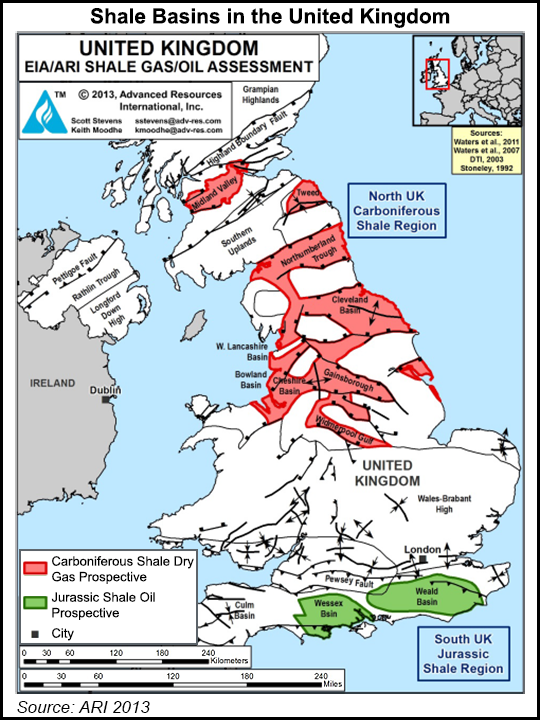E&P | NGI All News Access | NGI The Weekly Gas Market Report
Cuadrilla Encouraged by Initial Results from First UK Shale Well
Cuadrilla Resources Ltd. said natural gas flowed back from the UK’s first horizontal unconventional gas well in the Bowland Shale, noting initial results were “highly encouraging,” despite regulatory constraints on the amount of sand used in fracturing.

The UK-based producer has asked the nation’s Oil and Gas Authority (OGA) to “urgently review” the government’s Traffic Light System (TLS), which calls for a halt in operations if activities cause tremors of 0.5-magnitude or greater. Cuadrilla said most of the ground vibrations recorded during fracturing stages at the PNR-1 well, which targets the Bowland, were less than 0.5 millimeters/second.
“We have only partially tested this well, with just two out of the 41 stages installed along the horizontal section fractured fully as designed, and less than 14% of the sand we had planned to inject into the shale rock put in place,” said CEO Francis Egan. Nevertheless, Cuadrilla recorded a peak flowback rate at more than 0.2 MMcf/d and a stable rate of about 0.1 MMcf/d from PNR-1, which was drilled to a depth of more than 7,500 feet at the Preston New Road exploration site in Lancashire, a county in northwestern England.
Compared to a typical North American 2.5-kilometer (8,202-foot) long producing horizontal shale gas well, “with all of its stages fractured as planned,” data shows that the well could have an initial flow rate of 3-8 MMcf/d.
“This is a highly encouraging result and great news for the UK, which continues to import gas in ever increasing quantities by ship and long distance pipeline and has seen record demand for gas during the recent cold weather,” Egan said.
“The natural gas beneath Preston New Road could help secure our domestic gas supply and flow directly into the local grid, reducing carbon dioxide emissions associated with importing liquefied natural gas in tankers from around the world, including shale gas from the U.S., or piping gas to the UK over thousands of miles.”
The PNR-1 well is currently shut in, and Cuadrilla plans to “monitor build-up as it continues to assess the results.” Pending the outcome of a review of the TLS by the OGA, the company said it plans to complete fracturing operations at the well later this year. It also plans to fracture the PNR-2 well and flow test at both wells later this year.
Egan added that the company has shared seismic data from PNR-1 with the OGA and the British Geological Survey.
“We believe that there is more than ample evidence to justify an expert technical review of the TLS and, based on the outcome of that review, a revision at the PNR site, without compromising on safety,” Egan said. “We look forward to completing the job.
“All we ask now is that we are treated fairly, with comparable seismic and ground vibration levels to similar industries in Lancashire and elsewhere in the UK who are able to work safely but more effectively with significantly higher thresholds for seismicity and ground vibration.”
Cuadrilla received permission from the UK government to perform fracking operations at Preston New Road last July. In the months that preceded that decision, the company drilled two test wells at the site targeting the Lower and Upper Bowland, at depths of 7,546 and 6,890 feet, and with laterals measuring 2,625 and 2,461 feet, respectively.
© 2024 Natural Gas Intelligence. All rights reserved.
ISSN © 2577-9877 | ISSN © 1532-1266 | ISSN © 2158-8023 |
